This Mixed Grain Seeded Ciabatta, made with a portion of whole wheat flour (such as red fife or spelt) utilizes an overnight poolish, and incorporates a medley of seeds inside and out. This ciabatta also performs well when using a portion of buckwheat instead of, or in addition to, the whole wheat flour.
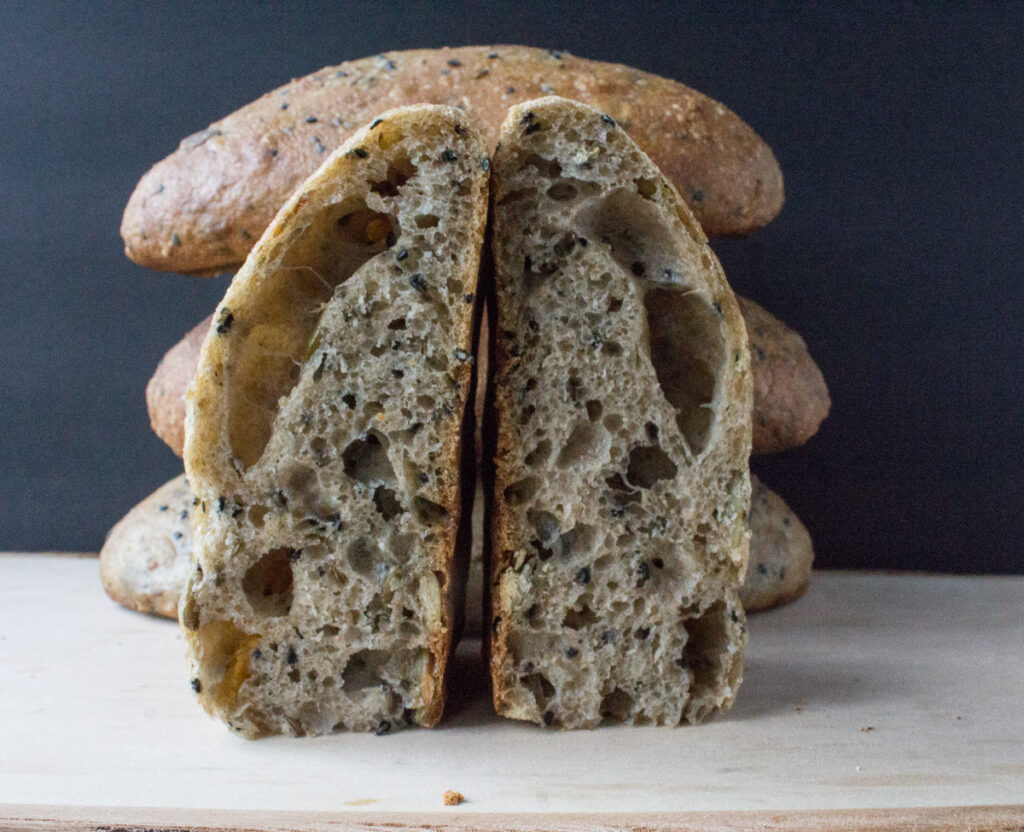
Mixed Grain Seeded Sourdough with Spelt
I am the host for the Bread Baking Babes this month which means I get to choose the bread of the month. It’s finally Spring, and since I’m a gardener, I wanted to make a bread that represents new growth.
The Babes have been making enriched breads for the past couple of months, so I thought we needed a bread that didn’t include any eggs or milk. I experimented with several different breads, and finally landed on this Mixed Grain Seeded Sourdough.
Since plants are beginning to emerge after being dormant over the winter, what better way to celebrate than to make a bread with seeds.
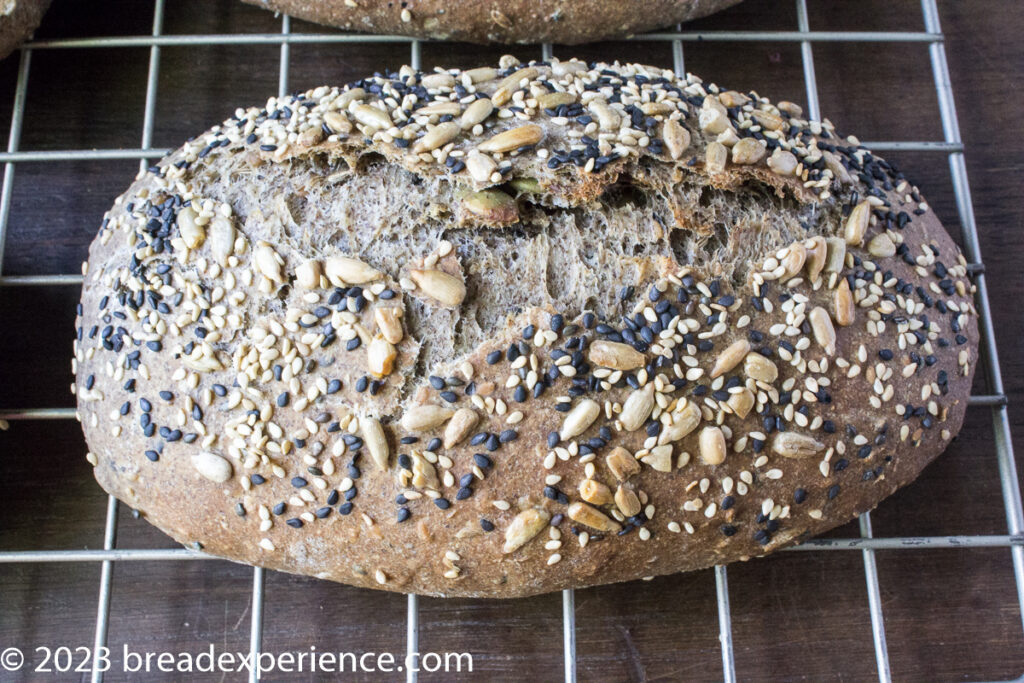
Mixed Grain Seeded Ciabatta with Buckwheat
About the poolish in this mixed grain seeded ciabatta
This ciabatta is adapted from the seeded ciabatta and buckwheat ciabatta formulas from The Larousse Book of Bread Recipes to Make at Home by Eric Kayser, and includes an overnight poolish similar to the method in The Fundamental Techniques of Classic Bread Baking from The French Culinary Institute.
I included a bit of sourdough in the poolish as well as some dried yeast in the final dough. If you don’t have a sourdough starter, or just prefer not to use sourdough, you can add a pinch of yeast to the poolish instead.
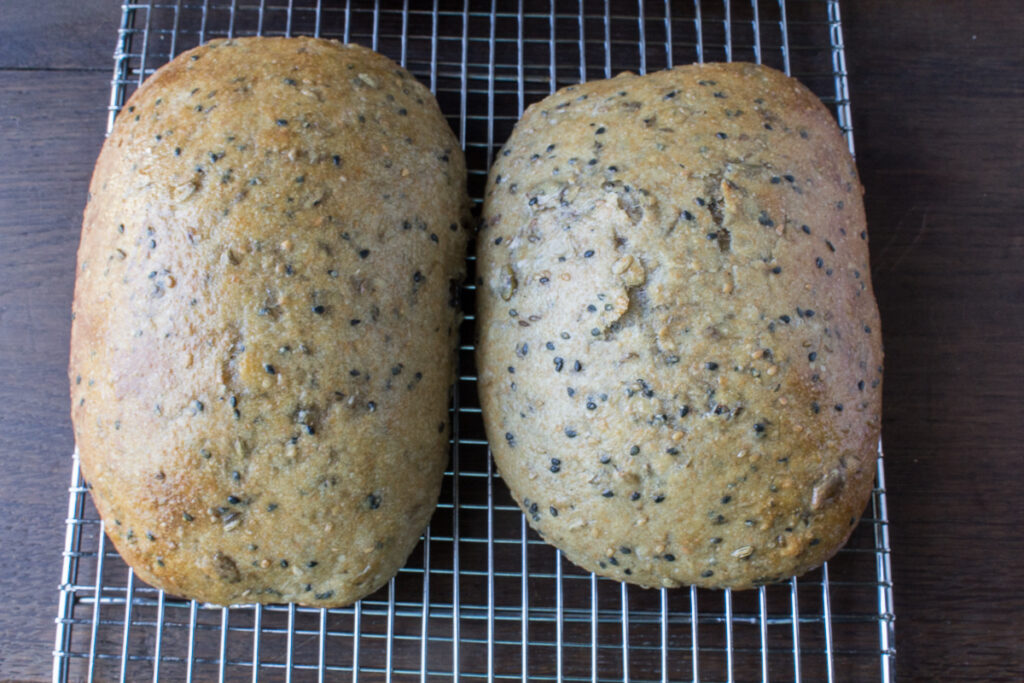
Mixed Grain Seeded Ciabatta with Spelt
The first time I made this bread, I tried it without the dried yeast in the final dough, and it was a bit flat. That version was made with 100 grams of buckwheat (which is gluten-free) so it didn’t provide any lift. The next time I made the buckwheat version, I included some dried yeast in the final dough.
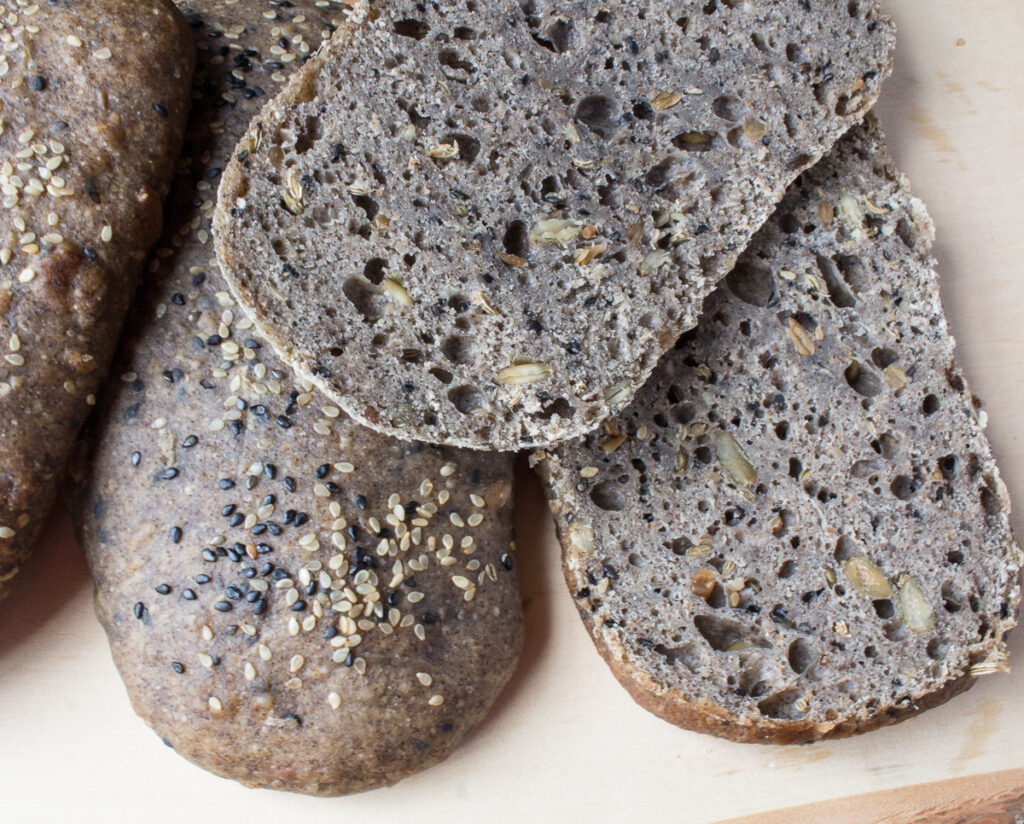
Mixed Grain Seeded Sourdough with Buckwheat and no added yeast
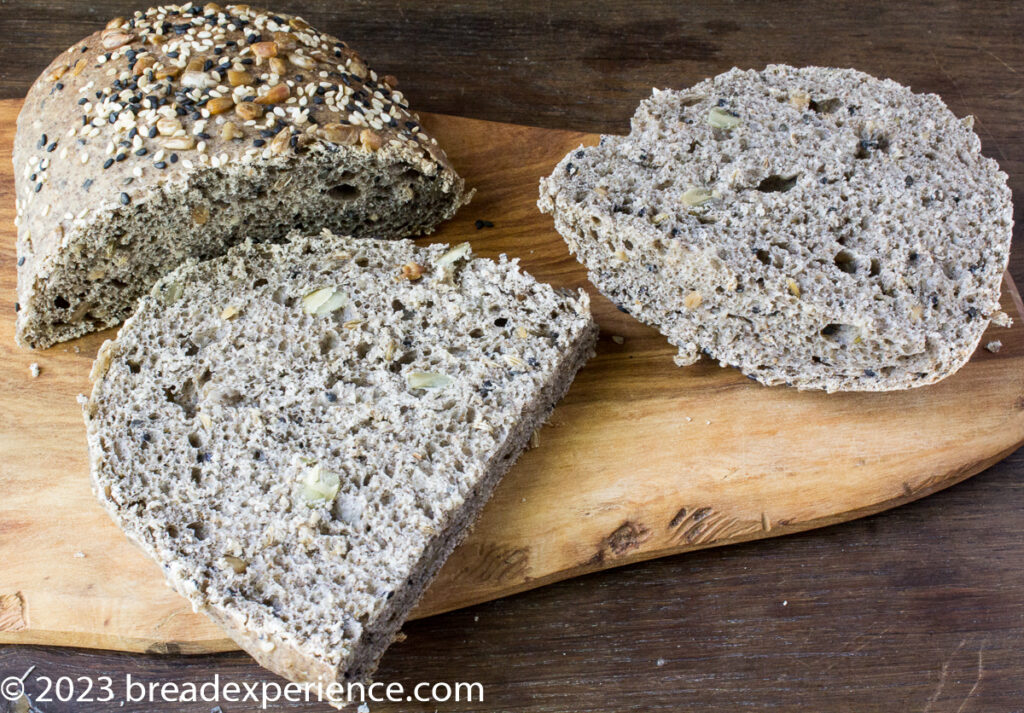
Mixed Grain Seeded Sourdough made with Buckwheat and 1/2 tsp dried yeast
If you use sourdough in the poolish, you may not need (or want) to add any dried yeast, depending on the type/amount of whole grain you use.
I made the second batch of this seeded ciabatta with about 30% whole grain spelt. I added 1/2 teaspoon of dried yeast to the dough. The spelt loaves were a bit overproofed so you might want to use less dried yeast when working with spelt, or reduce the proofing time (unless you want the big holes).
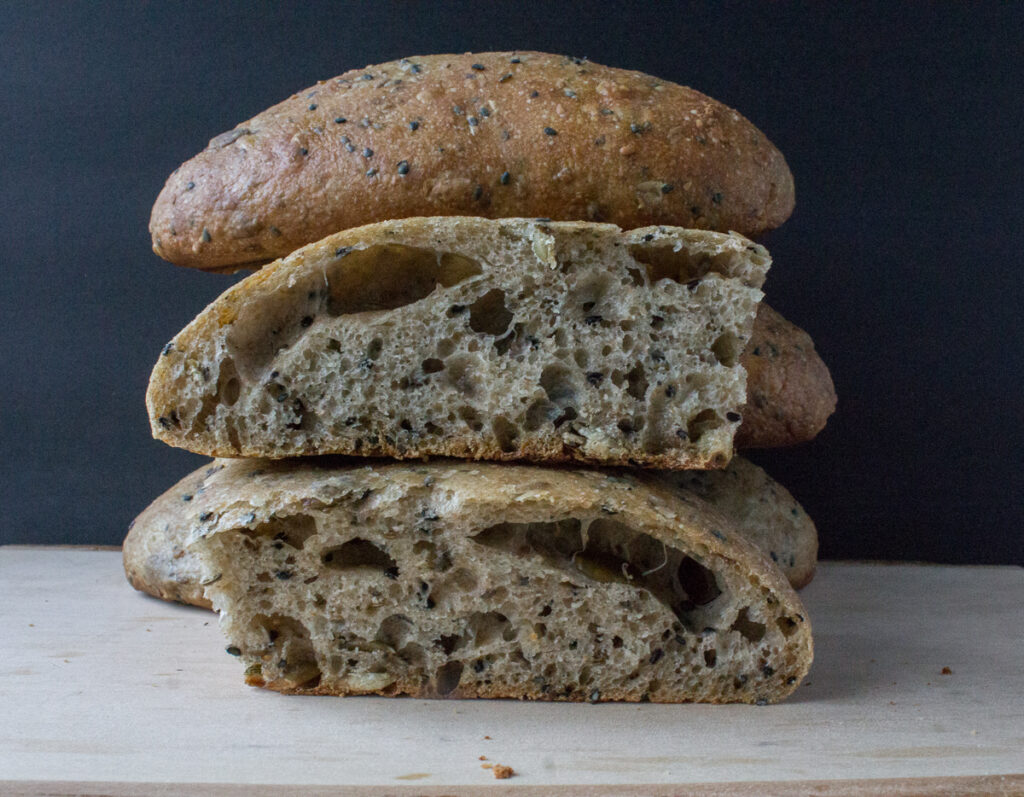
Mixed Grain Seeded Ciabatta with Spelt
Fairly easy and workable dough
I encourage you to use some whole wheat flour. I included some home-milled whole wheat red fife flour in the poolish and buckwheat or spelt flour in the final dough. I loved the flavor of both variations.
The dough for this ciabatta is fairly easy to work with. The hydration is about 75-80%. Depending on the type of whole wheat flour you incorporate, you may need to add more or less water when mixing.
Eric (the author of Larousse Book of Bread), shapes his loaves into a flattish rectangle to use for sandwiches. He then rolls the shaped loaves in more seeds.
I didn’t quite get the rolling-in-seeds part down. I spritzed the buckwheat loaves with a bit of water instead, sprinkled the seeds on top, and then pressed the seeds gently into the dough. I omitted that step with the spelt loaves.
- Buckwheat Loaves – 2nd Bake
- Spelt Loaves
Use your choice of seeds in this ciabatta
For the buckwheat loaves, I used pumpkin seeds, sunflower seeds, fennel seeds, and black and white sesame seeds in the dough and everything except the pumpkin seeds on the outside.
For the spelt loaves, I incorporated toasted pumpkin, fennel, and black and white sesame seeds in the dough only. I love the mix of seeds combined with the buckwheat and spelt flours.
I think this ciabatta tastes great with and without the seeds on the outside. I particularly liked it toasted and spread with avocado butter, but I also enjoyed it with peanut butter, and as a turkey sandwich.
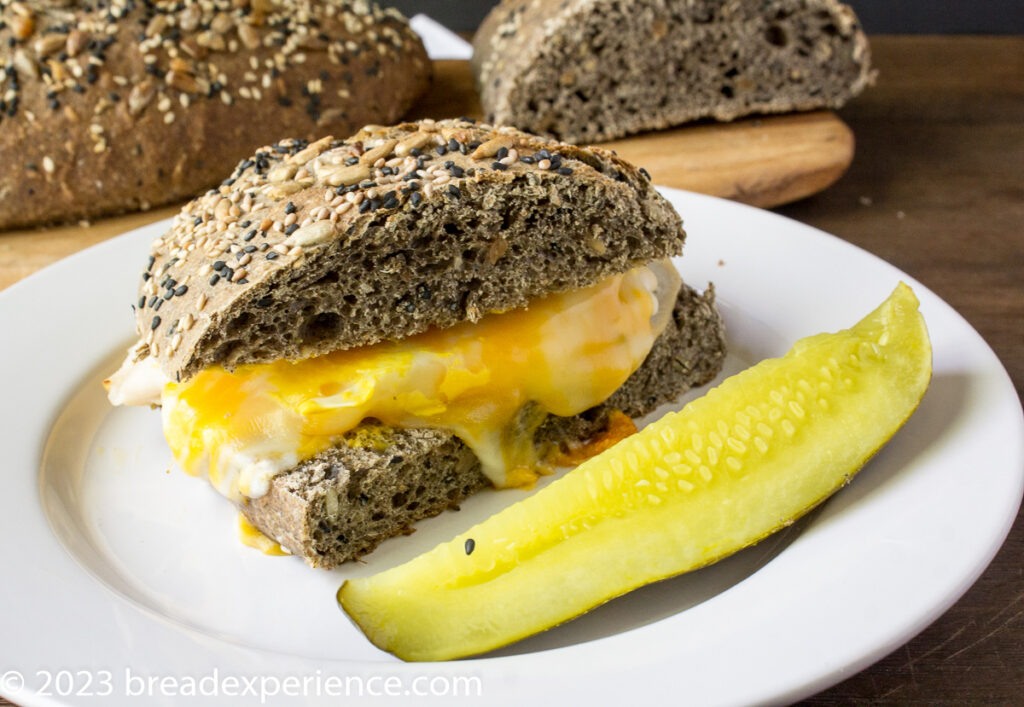
Turkey Sandwich on Mixed Grain Seeded Ciabatta with Buckwheat
Timing
- Evening before you plan to bake: Start the poolish
- Evening before or 2-3 hours before mixing final dough: Roast the seeds and let them soak for 2 hours.
- Next day: Mix the final dough, shape and bake the loaves.
Storing this seeded ciabatta
This mixed grain seeded ciabatta freezes well so you can enjoy some now and save some for later. Just place the loaves in a freezer-safe bag.
Print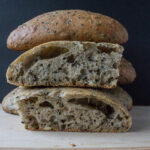
Mixed Grain Seeded Ciabatta
- Yield: 4 loaves 1x
Description
This Mixed Grain Seeded Ciabatta, made with a portion of whole grain flour (such as red fife, spelt, buckwheat) utilizes an overnight poolish, and incorporates a medley of seeds inside and out.
Ingredients
Poolish:
- 45 grams water
- 45 grams whole wheat flour (such as red fife or spelt)
- 15 grams sourdough starter or a pinch of dried yeast
Final Dough:
- 400 grams all-purpose flour
- 150 grams whole wheat flour (buckwheat, spelt, etc.)
- 350–385 grams water, divided
- Poolish all of the above
- 1/2 tsp. instant yeast
- 10 grams salt
- 30 grams extra virgin olive oil
- 90 grams mixed seeds (pumpkin, sunflower, fennel, sesame, millet, poppy, etc.)
- 1/2 cup water for soaking the seeds
- 1 cup ice cubes for steam
Instructions
Poolish:
- The evening before you plan to make the final dough, blend the whole wheat flour, water, and sourdough starter (or pinch of instant yeast) using a wooden spoon or dough whisk.
- Scrape down the sides of the bowl with a bowl scraper or spatula, cover, and set aside at warm room temperature (75 degrees F. / 25 degrees C.) for 12 to 14 hours.
Toast the seeds:
- The evening before, or 2-3 hours before you prepare the final dough, preheat the oven to 375 degrees F. Spread the seeds on a rimmed baking sheet and toast for 7 to 10 minutes. Depending on the type of seeds you choose, it could take more or less time. Watch the seeds so they don’t burn.
- Immediately tip the roasted seeds into a small bowl and cover with ¼ to ½ cup of water. Allow the seeds to soak for 2 hours. Drain the excess water before incorporating into the dough.
Final Dough: Mix by hand or use a stand mixer
- (Feel free to use a stand mixer to mix this dough, if desired. I mixed the dough by hand so those are the instructions I’ve included below.)
- In a large bowl, mix together the flours and 325 grams water. Cover, let rest 15 minutes.
- Add the poolish, along with the salt and instant yeast, and mix until fully incorporated. The dough should be slightly sticky.
- Drizzle in the olive oil and mix until thoroughly combined. Be patient with this process. Fold in the seeds. Add in additional water, a little at a time, if necessary and continue to mix until you have a smooth and elastic dough.
- Form the dough into a ball, place back in the bowl, cover and let rise in a warm place for 2 hours.
- After the first hour, uncover and fold the dough. Recover and let rest for 1 hour.
- Dust your work surface with flour. Divide the dough into 4 equal pieces (~280 grams each). Fold each piece over itself and stretch into a log. Cover the dough pieces with a damp towel and let rest 15 minutes.
- Take one piece of dough. Leave the other pieces covered. Using the palm of your hand, flatten it very gently. Fold a third of the dough (long side) toward the center and press along the edge with your fingers or the side of your hand. Fold the other long edge towards the center and press the seam closed with your fingers. Continue shaping the other 3 loaves the same way.
- If desired, coat the loaves with additional seeds (not soaked). Place the seeds on a plate. Brush or spray the loaves with water and press them into the seeds to evenly coat the tops. Transfer the loaves seamside down to a parchment lined baking sheet or seamside up on a baker’s couche heavily dusted with flour. (Although I enjoy using a baker’s couche, you don’t really need it for these loaves. The parchment works great.)
- Cover with a damp cloth and let the loaves proof for 1 hour.
- During the final proof, preheat the oven to 460 degrees F. with a baking stone on the lower middle rack and a steam pan or iron skillet on the top rack.
- Transfer the loaves (on the baking sheet) to the baking stone and immediately place 1 cup of ice cubes in the steam pan.
- Bake the loaves for 25 -30 minutes, rotating the pan partway through for even baking. The loaves should sound hollow when thumped lightly on the bottom.
- Remove the loaves from the oven and transfer to a wire rack. Brush lightly with olive oil, if desired.
Notes
Timing:
Evening before you plan to bake: Start the poolish
Evening before or 2-3 hours before mixing final dough: Roast the seeds and let them soak for 2 hours.
Next day: Mix the final dough, shape and bake the loaves.
Storing this seeded ciabatta:
This mixed grain seeded ciabatta freezes well so you can enjoy some now and save some for later. Just place the loaves in a freezer-safe bag.
- Category: Seeded Ciabatta
- Method: Poolish
- Cuisine: Italian
Who are the Bread Baking Babes?
We are a group of bread bakers who get together every month and bake bread! We have a Facebook group if you’d like to bake along. New recipes are posted every month on the 16th.
Bread Experience is the host kitchen this month. If you want to bake along with us, just bake the bread and post about it on your blog or in the BBB Facebook group by the end of the month. To receive your buddy badge, send an email to breadexperience at gmail dotcom.
Check out the different variations for this month’s bake:
Bread Experience – Cathy (Host Kitchen)
Karen’s Kitchen Stories – Karen
A Messy Kitchen – Kelly
Feeding My Enthusiasms – Elle
blog from OUR kitchen – Elizabeth
Judy’s Gross Eats – Judy
My Diverse Kitchen – Aparna
Thyme for Cooking – Katie (roundup)
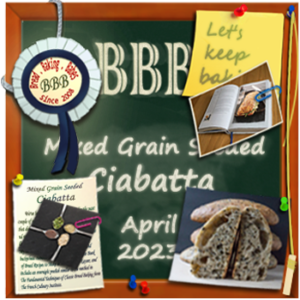
Happy Baking!
Cathy
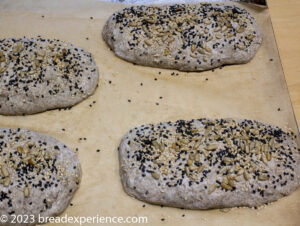
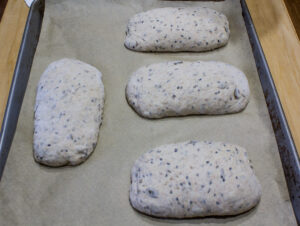
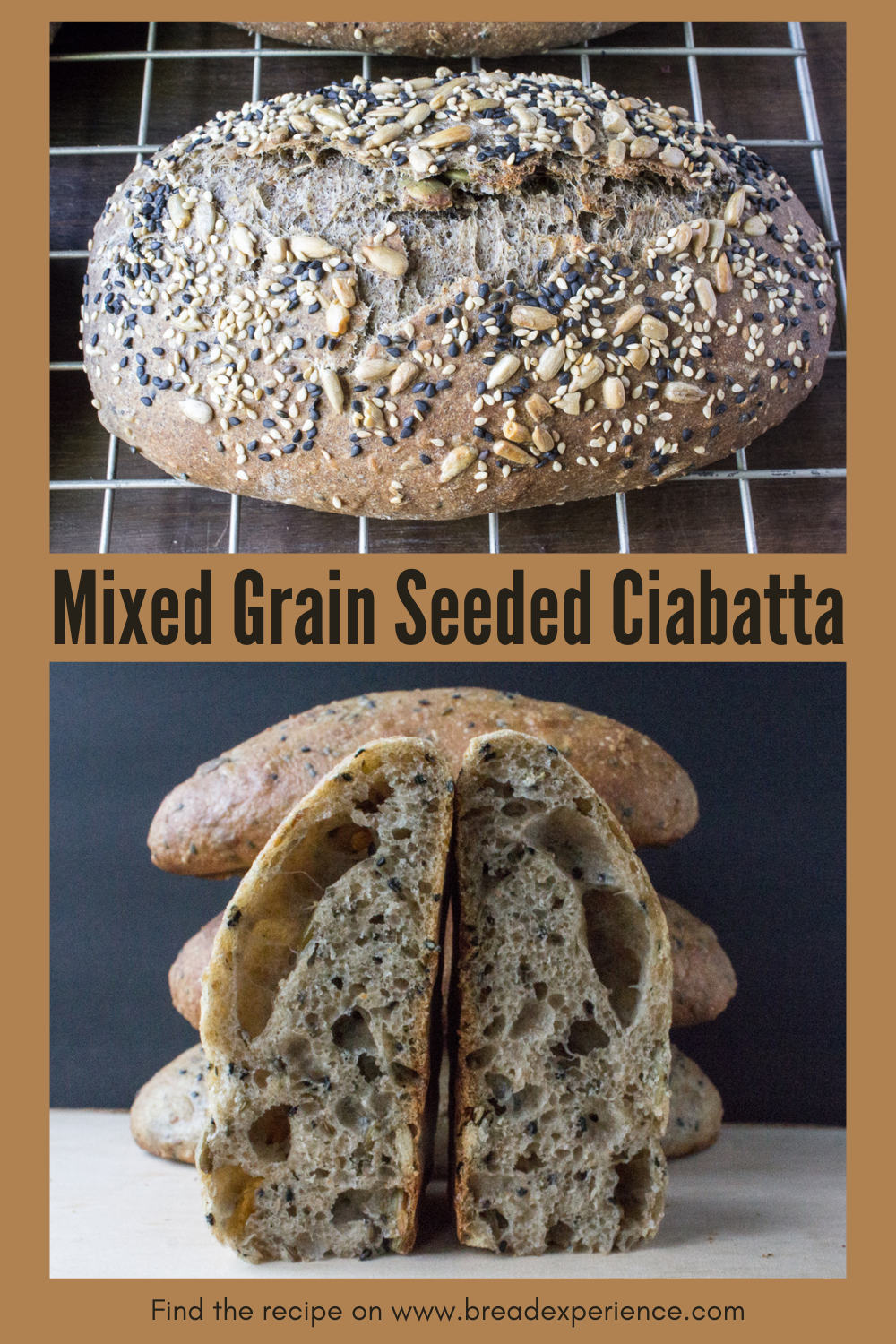
Karen says
Thanks for a great bread this month. The dough was super easy to work with and the bread tasted wonderful.
Cathy says
I’m so glad you enjoyed it! I thought the dough was easy to work with as well.
Kelly says
Wonderful bread, thank you Cathy! And now seeing your sandwiches, I am remembering a favorite panini that I haven’t had in years and would love to recreate! This would be absolutely delightful for that.
Cathy says
I’m glad you and your kids enjoyed it. Panini sounds wonderful!
Elizabeth says
Such beautiful bread, Cathy!
I can’t get over how easy it was to mix the dough for this bread. I kept wondering if maybe I hadn’t added enough water, because the dough was so lovely and pliable. Not sloppy at all!
Cathy says
This is not your typical high-hydration ciabatta which is one of things I really liked about this dough. You can actually shape it. I’m glad you enjoyed it.
Katie Zeller says
Gorgeous bread – a hit with all the Babe’s!
Cathy says
Thanks! This turned out to be a very tasty loaf.